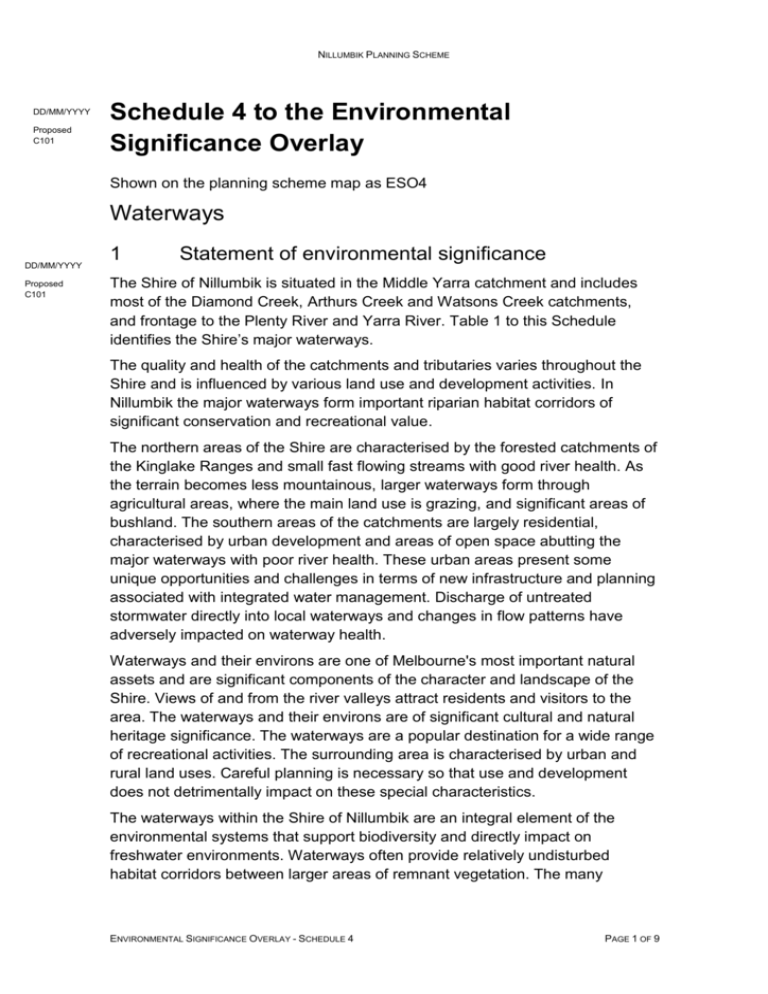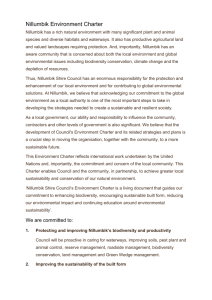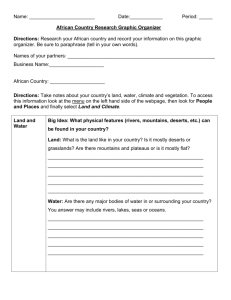Proposed C101 - Nillumbik Shire Council
advertisement

NILLUMBIK PLANNING SCHEME DD/MM/YYYY Proposed C101 Schedule 4 to the Environmental Significance Overlay Shown on the planning scheme map as ESO4 Waterways DD/MM/YYYY Proposed C101 1 Statement of environmental significance The Shire of Nillumbik is situated in the Middle Yarra catchment and includes most of the Diamond Creek, Arthurs Creek and Watsons Creek catchments, and frontage to the Plenty River and Yarra River. Table 1 to this Schedule identifies the Shire’s major waterways. The quality and health of the catchments and tributaries varies throughout the Shire and is influenced by various land use and development activities. In Nillumbik the major waterways form important riparian habitat corridors of significant conservation and recreational value. The northern areas of the Shire are characterised by the forested catchments of the Kinglake Ranges and small fast flowing streams with good river health. As the terrain becomes less mountainous, larger waterways form through agricultural areas, where the main land use is grazing, and significant areas of bushland. The southern areas of the catchments are largely residential, characterised by urban development and areas of open space abutting the major waterways with poor river health. These urban areas present some unique opportunities and challenges in terms of new infrastructure and planning associated with integrated water management. Discharge of untreated stormwater directly into local waterways and changes in flow patterns have adversely impacted on waterway health. Waterways and their environs are one of Melbourne's most important natural assets and are significant components of the character and landscape of the Shire. Views of and from the river valleys attract residents and visitors to the area. The waterways and their environs are of significant cultural and natural heritage significance. The waterways are a popular destination for a wide range of recreational activities. The surrounding area is characterised by urban and rural land uses. Careful planning is necessary so that use and development does not detrimentally impact on these special characteristics. The waterways within the Shire of Nillumbik are an integral element of the environmental systems that support biodiversity and directly impact on freshwater environments. Waterways often provide relatively undisturbed habitat corridors between larger areas of remnant vegetation. The many ENVIRONMENTAL SIGNIFICANCE OVERLAY - SCHEDULE 4 PAGE 1 OF 9 NILLUMBIK PLANNING SCHEME threatened flora and fauna species identified as existing in the Shire rely, to a great extent, on the watercourses in the Shire and therefore these areas need to be protected from inappropriate development. The significant fauna that occurs in or utilises these waterways include Macquarie Perch, Murray Cod, Dwarf Galaxias, Southern Pygmy Perch, Platypus, Bibrons Toadlet, Growling Grass Frog, Southern Toadlet, Large Footed Myotis, Eastern Broad-nosed Bat, Nankeen Night Heron, Black Falcon, Grey Goshawk, Barking Owl and Powerful Owl. 2 DD/MM/YYYY Proposed C101 Environmental objectives to be achieved To preserve the waterways in Nillumbik Shire by regulating the type, intensity and impacts of development adjacent to them. To protect, rehabilitate and extend continuous indigenous riparian vegetation corridors along waterways to improve existing wildlife habitat and movement corridors. To protect and improve waterway health, environmental flows and water quality. To protect natural landforms, natural stream geomorphology, geological formations. To protect areas of sensitivity for Aboriginal heritage. To maintain the ability of waterways to carry natural flows and ensure there is no loss of floodplain storage as a result of buildings and works. To allow natural changes to watercourses and stream morphology to occur over time. To prevent unnatural erosion of banks, streambeds and adjoining land and the siltation of watercourses, drains and other features. To prevent further modification and restore those sections of waterway corridors which have been previously modified to create dams, artificial beds, banks and landforms to a more natural, visually attractive and ecologically connected and diverse landscape. To minimise the impact of rural activities on the environmental values of waterways. To encourage the use of sustainable agricultural practices, including amending Crown land water frontage licences to riparian management licences, removal of stock access to waterways and no-till farming. To discourage subdivision to enable retention of continuous native vegetation within larger lots. ENVIRONMENTAL SIGNIFICANCE OVERLAY - SCHEDULE 4 PAGE 2 OF 9 NILLUMBIK PLANNING SCHEME To ensure development results in no net increase in the rate or quantity of stormwater, sediment or other pollutants entering watercourses or wetlands. To discourage urban development, impervious surfaces, earthworks, tree removal or any other works, intensive use and development that will undermine the health of waterways and their habitat values. To ensure new development and works minimises runoff into waterways and any runoff is adequately treated prior to entering the waterway to ensure water quality is not affected in accordance with best practice environmental management. To encourage Integrated Water Management (IWM) projects to store and reuse, or treat and filter, stormwater prior to entering waterways. To ensure that in established residential areas, the construction of outbuildings and dwelling additions results in no loss or encroachment into the environmental, cultural or landscape values of waterways. To ensure that any new development is sufficiently set back from waterways, is sensitively designed and sited, and utilises muted building materials and colours to reinforce the existing environmental characteristics and values of the area, including not being visually prominent or obtrusive when viewed from the creek corridor or recreational trails. Lights should be baffled to avoid light spill to open space areas. To protect and enhance a sense of remoteness along waterways and its environs. To address potentially threatening processes listed under the Flora and Fauna Guarantee Act 1988. To ensure the ecosystem services provided by riparian environments are properly valued and considered. To protect areas along watercourses from development and loss of vegetation that may damage the streamside environment as a visual, conservation, ecological and recreation resource. To protect and enhance biodiversity values including the diversity, integrity and health of local flora and fauna habitats within and along watercourses. To retain mature, dead and dying trees as habitat for native fauna. To provide adequate habitat and buffers to nest and roost trees of large owls. To encourage the restoration, regeneration and revegetation of indigenous riparian vegetation, especially canopy trees, to improve the natural values of waterways particularly where it has been significantly cleared. To prevent further loss and maintain the current extent and quality of native vegetation by avoiding the removal of native vegetation. ENVIRONMENTAL SIGNIFICANCE OVERLAY - SCHEDULE 4 PAGE 3 OF 9 NILLUMBIK PLANNING SCHEME To minimise the removal of native vegetation, if the removal of native vegetation cannot be avoided, through appropriate planning and design. To appropriately compensate any loss of native vegetation, preferably on-site through revegetation of riparian areas. To create and maintain continuous open space corridors along waterways. To encourage public access and recreational use along waterways, including provision of shared use trails and shared use of water access locations. To protect potential connections from the creek corridor to community facilities, other open space trails and the regional open space network. 3 DD/MM/YYYY Proposed C101 Permit requirement Buildings and works A permit is required to construct buildings and works associated with a dependent person’s unit. A permit is required to construct a domestic swimming pool or spa and associated mechanical and safety equipment. A permit is required to construct a fence. This does not apply if the fence is: of post and wire construction, not greater than 1.4 metres in height, has no more than five horizontal strands of plain wire where a minimum gap of 30 centimetres is maintained between the ground level and the lowest wire and contains no barbed wire; or of post and wire and mesh construction, not greater than 1.4 metres in height with mesh squares no less than 15 centimetres in width, has no more than five horizontal strands of plain wire where a minimum gap of 30 centimetres is maintained between the ground level and the lowest wire and contains no barbed wire; or of rabbit proof mesh construction, not greater than 1.4 metres in height with rabbit proof mesh no more than 5cm in width and contains no barbed wire. A permit is required for earthworks. This does not apply if the earthworks are to the minimum extent necessary to remove pest animal burrows for the purpose of vermin control, provided the works area is reinstated back to natural ground level and no vegetation requiring a permit for its removal is removed or destroyed. A permit is not required for works undertaken by a public authority in accordance with a management plan endorsed by the responsible authority. A permit is not required for any waterway improvement works undertaken by Melbourne Water. ENVIRONMENTAL SIGNIFICANCE OVERLAY - SCHEDULE 4 PAGE 4 OF 9 NILLUMBIK PLANNING SCHEME A permit is not required to mitigate flooding, respond to emergencies including in-stream vegetation removal to relieve flood risk or duration. Vegetation A permit is required to remove, destroy or lop any vegetation, unless: The vegetation is identified as a pest plant in the Shire of Nillumbik Environmental Weed List 2015 as incorporated in this scheme. The vegetation has been planted or grown for shelter belts, woodlots, street trees, or gardens. This exemption does not apply if vegetation was planted for conservation purposes with public funding. The works are undertaken by or on behalf of Parks Victoria and Melbourne Water as public land managers. 4 DD/MM/YYYY Proposed C101 Application requirements Buildings and works An application to construct a building or construct or carry out works must be accompanied by the following information, as appropriate, to the satisfaction of the responsible authority: A site plan (drawn to scale) including: Dimensions of any existing building envelope with setbacks to all boundaries. The setbacks of buildings and works to all boundaries. The location, extent and type of vegetation on the site and vegetation to be removed. Accurate and detailed existing and proposed finished site levels. The location, proposed gradient and finished level at the top and toe of all batters. Cross sections to illustrate the extent of cut and fill. Details of retaining walls including height, materials and, if required, drainage. The location, gradient and alignment of driveways and any associated earthworks. The location, type and size of any effluent disposal system including any effluent envelope. The location of any easements. ENVIRONMENTAL SIGNIFICANCE OVERLAY - SCHEDULE 4 PAGE 5 OF 9 NILLUMBIK PLANNING SCHEME The location, depth and width of proposed underground services and trenches. Complete building elevations detailing wall height above natural ground level and overall height above natural ground level. Floor plan including finished floor levels. The proposed external building finishes and colours. Demonstration that adverse environmental impacts will be avoided, or where they cannot be avoided, minimised so that waterway health and the biological integrity of the area is conserved and protected. This includes avoiding or minimising the likely impact of any proposed subdivision and possible future development of the lots, including: Removal of vegetation Earthworks. Changes to the hydrology and drainage pattern. A Construction Environmental Management Plan outlining measures to be undertaken to minimise environmental impacts during the construction period, including soil conservation, waterway and vegetation protection measures. If in the opinion of the responsible authority any requirement is not relevant to the evaluation of an application, the responsible authority may waive or reduce the requirement. Subdivision An application to subdivide land must be accompanied by the following information, as appropriate to the satisfaction of the responsible authority: A site analysis, documenting the site in terms of land form, vegetation coverage and the relationship with surrounding land, and a report explaining how the proposed subdivision has responded to the site analysis. A site plan (drawn to scale) including: Contours of the land. A dimensioned building envelope with setbacks to all boundaries. A dimensioned effluent envelope, as appropriate, with setbacks to all boundaries and drainage lines. The setbacks of existing buildings to all boundaries. The location, extent and type of vegetation on the site. ENVIRONMENTAL SIGNIFICANCE OVERLAY - SCHEDULE 4 PAGE 6 OF 9 NILLUMBIK PLANNING SCHEME The location, gradient and alignment of any existing or proposed driveways and any associated earthworks. The location, type and size of any effluent disposal system including any effluent envelope. The location of any existing or proposed easements. The location, depth and width of proposed underground services and trenches. Demonstration that adverse environmental impacts will be avoided, or where they cannot be avoided, minimised so that the biological integrity of the area is conserved and protected. This includes avoiding or minimising the likely impact of the proposed subdivision and possible future development of the lots, including impacts resulting from: Removal of vegetation Earthworks Changes to the hydrology and drainage pattern Measures to be undertaken to minimise environmental impacts during the construction period, including soil conservation, waterway and vegetation protection measures. If in the opinion of the responsible authority any requirement is not relevant to the evaluation of an application, the responsible authority may waive or reduce the requirement. Vegetation An application to remove, destroy or lop native vegetation must be accompanied by the following information, as appropriate, to the satisfaction of the responsible authority: An Ecological Assessment including: A site plan (drawn to scale) showing: The boundaries of the site. The extent of existing vegetation and vegetation to be removed, including the location of any hollow bearing trees. Topographic information including ridges, crests and hilltops, streams and waterways, drainage lines, slopes of more than 20 percent, low lying areas and areas of existing erosion and salinity. The location of any buildings and any other structures on site. A description of the native vegetation to be removed, including: ENVIRONMENTAL SIGNIFICANCE OVERLAY - SCHEDULE 4 PAGE 7 OF 9 NILLUMBIK PLANNING SCHEME A habitat hectare assessment including identification of habitat zones, their quality and Ecological Vegetation Class, and a list of species present and their conservation significance. The species, size and number of trees over 10 centimetres diameter at breast height, measured at 1.4 m above natural ground level. A written explanation of the reasons for the native vegetation removal and steps that have been taken to avoid, minimise and appropriately compensate the loss of native vegetation. Any planting or revegetation must utilise plants from the EVC/s on-site. A description of any flora and fauna species that are rare or threatened at the regional, state or national level, that have been recorded within 1.5 kilometres of the site or which are known to be or likely to be present at the site, including: The conservation status of each species. An assessment of the likelihood that the site provides habitat for each species and the impact of the proposal on the habitat of each species. Actions to avoid and minimise adverse impacts on threatened species. A flora and fauna survey including targeted threatened species search. An arborist’s assessment of any trees which are proposed to be removed for safety reasons. If in the opinion of the responsible authority any requirement is not relevant to the evaluation of an application, the responsible authority may waive or reduce the requirement. 5 DD/MM/YYYY Proposed C101 Referral of applications All applications must be referred in accordance with Section 55 of the Act to the referral authority specified in Clause 66.04 or a schedule to that clause unless in the opinion of the responsible authority, the proposal satisfies requirements or conditions previously agreed to in writing between the responsible authority and the referral authority. 6 DD/MM/YYYY Proposed C101 Decision guidelines Before deciding on an application, the responsible authority must consider, as appropriate: General The effect of the proposal on catchment health and platypus populations. ENVIRONMENTAL SIGNIFICANCE OVERLAY - SCHEDULE 4 PAGE 8 OF 9 NILLUMBIK PLANNING SCHEME The need to retain a buffer strip of vegetation along watercourses and other natural features which contribute to the health, water quality and visual character of the waterway. The role of native vegetation in contributing to faunal and habitat value and the need to protect native vegetation that forms part of a habitat link The extent to which the proposal will affect the ecological values and function of the waterway and catchment. The extent to which the proposal will impact on stream flows, flooding and natural inundation rates and water quality. The effect on the natural beauty and on the future enjoyment of and access to the area by the community. The current and proposed future use of land adjacent to the waterway and the effects on existing and proposed infrastructure. The Diamond Creek Catchment Local Management Plan and any other relevant waterway management strategy. Whether the proposal could result in a potentially threatening process listed under the Flora and Fauna Guarantee Act 1988 occurring. Whether appropriate land management practices are proposed and recorded in a Property Management Plan, especially removal of stock access to waterways. Whether habitat improvement works have been proposed such as artificial hollow creation, nest boxes, additional logs or rope bridges. Whether the land is capable of retaining, treating and disposing effluent and other wastes where connection to a reticulated sewerage system is not available. Whether the proposal incorporates appropriate measures to prevent: pollution to waterways; increased nutrient loads to waterways; siltation and increased turbidity of water in water courses; and detrimental alterations to flow regimes of streams and watercourses. Buildings and works Whether the proposal adopts appropriate siting, design and management measures to avoid or minimise any adverse impacts on native vegetation, habitat values, hydrology, land stability, habitat corridors, ecological stepping stones or adjacent open space. ENVIRONMENTAL SIGNIFICANCE OVERLAY - SCHEDULE 4 PAGE 9 OF 9 NILLUMBIK PLANNING SCHEME The effect of the height, bulk spacing, setback and general appearance of any proposed buildings and works on the environmental values and visual character of the waterway and its environs. All buildings must be located at least 10 metres from any land within a Public Park and Recreation Zone or Public Conservation and Resource Zone, and any cliff edge. The need for landscaping or vegetation screening. The materials used to construct any proposed fencing and whether the fencing is consistent with the Guidelines for riparian fencing in flood-prone areas, DELWP, 2015. The extent to which the development minimises the need for earthworks. Whether the development incorporates water sensitive urban design measures to improve the quality and quantity of stormwater exiting the site. Whether the proposal is consistent with the Shared Pathway Guidelines, Melbourne Water, 2009. Subdivision Whether the subdivision adopts lot sizes, boundary alignments and layouts, road network, water sensitive urban design measures and open space areas that will avoid or minimise any adverse impacts on native vegetation, habitat values, hydrology, land stability, habitat corridors, ecological stepping stones or adjacent open space. Vegetation Removal The type, extent, quality and significance of vegetation to be removed. The effect of the proposed removal of vegetation on the habitat value, wildlife corridor and long tern viability of the vegetation along the waterway. The reasons for removing the vegetation and the practicality of alternative options which do not require the removal of vegetation. Whether the removal of native vegetation has been avoided and minimised as much as possible. Whether the proposal includes revegetation, especially of waterways, provision of a Land Management Plan, and/or placement of a security agreement over vegetation on the property to compensate for vegetation removal. ENVIRONMENTAL SIGNIFICANCE OVERLAY - SCHEDULE 4 PAGE 10 OF 9 NILLUMBIK PLANNING SCHEME 7 Table 1 Summary of major waterways located in the Shire of Nillumbik DD/MM/YYYY Waterway Description Proposed C101 Yarra River The section of the Yarra River flowing through Nillumbik is classified as the Middle Yarra. The portion downstream of Nillumbik flows into Melbourne Central Business District and Port Phillip Bay. Diamond Creek Diamond Creek begins on the Kinglake Plateau and flows through St Andrews, Cottlesbridge, Hurstbridge, Wattle Glen, Diamond Creek and Eltham, before entering the Yarra River at Eltham Lower Park. Plenty River Beginning at Mount Disappointment, the Plenty River flows through Mernda, Whittlesea and Yarrambat and the urban areas of Greensborough before entering the Yarra River at Lower Plenty. Watsons Creek Watsons Creek begins in Kinglake National Park and passes through rural land in Christmas Hills, Watsons Creek, Smiths Gully and Kangaroo Ground, before entering the Yarra River at the Bend of Islands Conservation Zone. Arthurs Creek Arthurs Creek begins in the Kinglake National Park and flows through rural land, passing through Arthurs Creek, Strathewen and Nutfield before joining the Diamond Creek at Hurstbridge. 8 References DD/MM/YYYY Proposed C101 Better Bays and Waterways, A water quality improvement plan for Port Phillip Bay and Western Port, Melbourne Water, 2009. Diamond Creek Catchment Local Management Plan 2015, Melbourne Water, 2015. Flora and Fauna Survey Assessment Documents, Melbourne Water, 2011. Guidelines for riparian fencing in flood-prone areas, DELWP, 2015. Heathy Waterways Strategy, Melbourne Water, 2012. Nillumbik’s Integrated Water Management Strategy, Nillumbik Shire Council, 2012. ENVIRONMENTAL SIGNIFICANCE OVERLAY - SCHEDULE 4 PAGE 11 OF 9 NILLUMBIK PLANNING SCHEME Nillumbik Shire Council State of Environment Report, Nillumbik Shire Council, 2014. Nillumbik Sites of Significance Review Rural Areas, Abzeco, 2014. Waterway corridors; Guidelines for greenfield development areas within the Port Phillip and Western Port region, Melbourne Water, 2013. ENVIRONMENTAL SIGNIFICANCE OVERLAY - SCHEDULE 4 PAGE 12 OF 9








